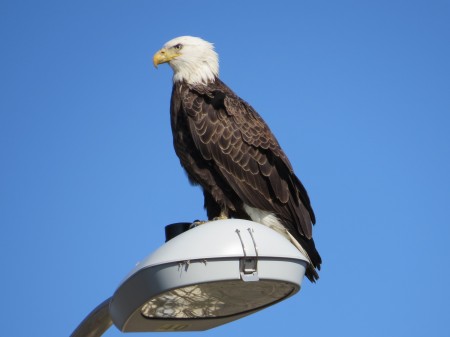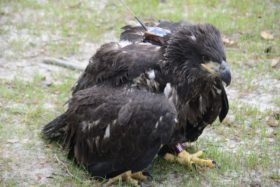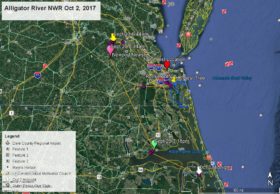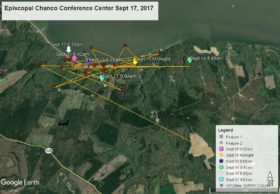Urbanized Bald Eagle
Camellia Returns to Princess Anne Country Club Feb 27 2014
February 27, 2014KE Remains At Swift Creek Reservoir Feb 27 2014
March 1, 2014A small portion of the population of bald eagles, perhaps 5 percent, are considered to have habitated to our human environment with all its sounds and activities. Donald and Lillian Stokes in their book A Guide To Bird Behavior Volume III write “Unlike the Osprey, which tolerates human presence, the bald eagle demands more isolation from human activity”. Dr. Paul A. Johnsgard in his book Hawks, Eagles & Falcons of North America states “freedom from human disturbance is usually an important but highly variable factor”. These days the word “variable” is key.
The portion of the bald eagle population that has become “urbanized” is expanding. The bald eagle nestlings that are growing up in nests in peoples backyards, public parks, golf courses and other human occupied locations peer out of their nests viewing all our human activities and the sounds we make. When they fledge from their nests they are acclimated to these sounds, sights, and noises and do not shy away from our human locations. Take for example the bald eagle named Camellia who was fitted with a satellite transmitter at his nest at Norfolk Botanical Garden and fledged May 27, 2010. Camellia has spent the vast majority of his time since then in human occupied areas like residential neighborhoods and golf courses – where Camellia is now in Virginia Beach, VA (http://eagletrak.blogs.wm.edu).
On Feburary 27, 2014, I was driving toward the Honey Bee Golf Course in Virginia Beach to check on another Norfolk Botanical Garden raised bald eagle named HK, because of the purple band on his left leg. HK has built a nest on the golf course. The nest tree is less than 100 feet from a private house and 20 feet from a public road. Before I got to the golf course I saw yet another sign that bald eagles have habituated to our human environment – a bald eagle sitting atop a highway light over South Independence Blvd at the entrance to a Target store. I did a u-turn, pulled into a parking space and took the attached photographs as the bald eagle sat there for another 15 minutes with cars, trucks, motorcycles and school busses passing directly below.
Photographs copyright Reese F Lukei Jr.









13 Comments
Love this article and pictures Reese. I’m glad that Bald Eagles have adapted so well. Last picture made me laugh — you were getting a look!
Oh my.. what a beautiful sight..surprised a line of car’s had not pulled over ..Yeah Reese you were getting the “look”..Thanks for shareing…
Response – Hi Pat – You would think that a bald eagle that was that obvious would have gotten peoples attention. During the 15 minutes that I was there only two people stopped to get a closer look.
It certainly is thrilling to be able to drive around in a busy area such as Hampton Roads and see eagles soaring or sitting when years ago a single rare sighting would be more commonplace. I’m still waiting for one to find my pine tree! Thanks, Reese.
That is so cool! Your pictures are beautiful. Thanks for sharing them with us, Reese.
So cool. Thanks for sharing those photos.
Hi Reese, What a surprising read and the pictures are great. 🙂 We at EOA miss hearing from you and reminisce often about our contact with you and all that we’ve shared at NBG. We hope that we will have that pleasure again soon. Thanks for sharing.
People not looking up is normal. Even at NBG not to many did.
We are conditioned to look up 🙂
Hi Reese, this is truly the case at the nest located 5 miles from Pittsburgh. I am amazed by the noise at this nest. There are trains running below this nest every few hours and they even blare their horn. The eagles take it all in stride and hardly seem to notice it. Also, thanks for sharing your pictures. That is one gorgeous eagle.
Great photos, Reese. Saw an eagle flying over West Neck Marina this week. Hope to run into you at Honeybee soon.
Am I the only one who finds this a bit disturbing? I hate that society has encroached so on the animal’s territory that it is necessary for them to acclimate and urbanize. I love seeing them, but wish they’d stay away from people and cities.
It’s very exciting to view these urbanized eagles while living life. Hard to imagine many people didn’t stop to look, yet we encounter that often.
Thanks for the interesting post Reese, it’s almost as good as your last one!
Hi Reese. It was an omen to have seen you with your camera that beautiful Thursday. Thank you again for sharing your photograph and thank you for pointing the eagle out to me. It made my wedding day even more special. I will now continue to follow your blog. Warmest regards, Judy
In the city people are oblivious…but when I drive out in the country it is common to see cars slow down or even stop to view and photograph the hawks, eagles and osprey.